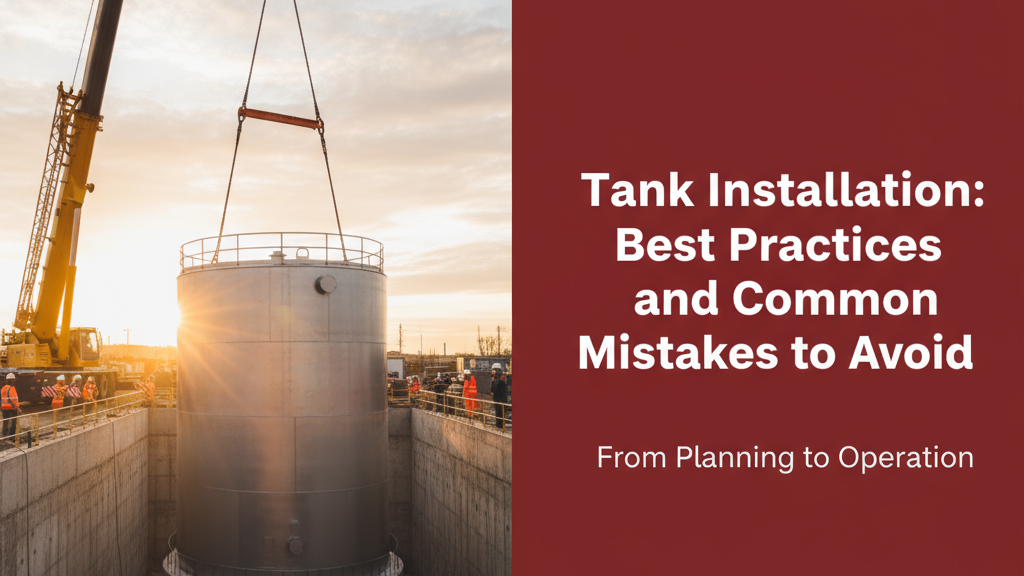Introduction to Proper Tank Installation
Installing a water storage tank correctly ensures longevity, prevents leaks, and maintains water quality. Whether you’re fitting a small overhead tank or a large subterranean tank, following structured best practices avoids common failures seen across Indian homes – from cracked foundations during monsoons to algae growth from improper shading.
Essential Pre-Installation Checks
Before installation begins, verify:
- Tank capacity: Match the tank size (usually 500–10,000 litres) to your household/building’s daily water requirement (average 135–225 litres per person)
- Material suitability: For overhead tanks, UV-stabilised polyethylene resists monsoons and heat (withstands -10°C to 60°C); underground tanks may require corrosion-resistant materials
- Certifications: Ensure ISI mark (IS 12701 for PE tanks) and manufacturer’s warranty documents
- Accessories: Check all fittings (inlets, outlets, vents, overflow pipes) are included
Choosing the Right Location
Consider these factors:
| Site Type | Recommendations |
|---|---|
| Overhead tanks | Centred above load-bearing walls; minimum 1m clearance from parapets for maintenance |
| Ground-level tanks | Shaded areas to prevent algae; 1.5m from trees to avoid root damage |
| Underground tanks | Clear of sewage lines and septic tanks; accessible for cleaning via manhole covers |
Preparing the Installation Site
A proper foundation prevents 60–70% of premature tank failures:
- Overhead tank stands: Use M20 grade concrete (1:1.5:3 mix) with >150mm thickness; steel stands require anti-rust paint
- Ground placement: Compacted earth with 75mm thick PCC (plain cement concrete) layer
- Underground pits: 150mm larger than tank dimensions on all sides with drainage layer
Step-by-Step Tank Installation Process
- Position the tank with inlet/outlet ports correctly oriented
- Use levelling tools (spirit level) to ensure <3mm/m tilt
- Secure with manufacturer-provided clamps/straps (every 1.5m for large tanks)
- Leave 50–100mm air gap between tank and walls/structures
Connecting Plumbing and Fittings
Avoid these frequent errors:
- Pipe misalignment: Causes stress cracks – use flexible connectors or 45° elbows
- Unprotected inlets: Fit mosquito mesh (1mm holes) and non-return valves
- Overflow positioning: Direct overflow 300mm away from foundations to prevent soil erosion
Common Tank Installation Pitfalls
Incorrect Levelling and Alignment
Even slight tilts cause uneven weight distribution, leading to:
- Premature seam failures in plastic tanks
- Overflow from one side while the other remains underfilled
Improper Venting and Overflow Setup
Inadequate ventilation (minimum 25mm diameter vent) creates vacuum during drainage, while missing overflow pipes risk monsoon overflows.
Inadequate Foundation Preparation
Foundations with poor compaction or incorrect dimensions often shift during monsoons, stressing tank seams.
Post-Installation Testing and Maintenance
After installation:
- First fill: Check for leaks at all joints for 24 hours
- Quarterly: Clean sediment (more frequent in high-TDS water areas)
- Annual: Inspect foundations/preventative tightening of fixtures
Safety Considerations for Tank Installation
- Overhead tanks exceeding 750L require structural engineer approval
- Underground tanks need proper shoring during pit excavation
- Always disconnect power when installing near electrical lines
FAQs About Tank Installation
Can tanks be installed on rooftops without reinforcement?
Only if the roof slab capacity exceeds the tank weight (water + tank). As rule, 1 litre water = 1kg; add 10–15% for tank weight.
How often should underground tanks be inspected?
Biannually for cracks or groundwater infiltration signs (moisture around lids).
Do plastic tanks need protection from sunlight?
UV-stabilised tanks withstand sunlight, but shading extends lifespan by reducing thermal expansion cycles.

